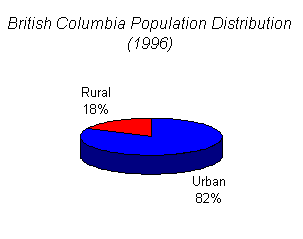Facts at a Glance |
|
|
Capital:
|
Victoria |
British Columbia

|
Camelid Country Home Page. |
|
Facts at a Glance |
|
|
Capital:
|
Victoria |
British Columbia

The province of British Columbia has a total area of 365,946 square miles (947,800 square kilometers), making it the third largest province in Canada by total area. 6,975 square miles (18,070 square kilometers.) of this is covered by freshwater lakes.
British Columbia is a coastal province with 20,348 miles (32,747 kilometers) of coastline. This includes the coasts of islands and the land bordering estuaries.
In 1996, there were 285,096 acres (114,038 hectares) of irrigated land in the province. This is up sharply from 234,413 acres (93,765 hectares) under irrigation in 1991.

British Columbia has the largest population of the four western Canadian provinces. It also has the highest percentage of the population living in urban areas.
According to the 1996 Census, approximately 82% of British Columbia's 3,724,500 people lived in urban areas of the province. The remaining 18% live in rural areas.
For the purposes of the census, Statistics Canada defines urban areas as those that "have a minimum population concentration of 1,000 and a population density of at least 400 per square kilometre, based on the previous census population counts." All remaining areas in the province are rural areas.
In 1996, there were 21,835 census farms in the province of British Columbia, of which 3,400 generated gross farm receipts of $100,000CAN or more.
For statistical purposes, Statistics Canada defines a census farm as an agricultural operation "producing at least one of the following products for sale: Crops (field crops, tree fruits or nuts, berries or grapes, vegetables, seed), Livestock (cattle, pigs, sheep, horses, game animals, other livestock), Poultry (hens, chickens, turkeys, chicks, game birds, other poultry), Animal Products (milk or cream, eggs, wool, furs, meat), or Other Agricultural Products (greenhouse or nursery products, Christmas trees, mushrooms, sod, honey, maple syrup products)."
The aveage census farm size was 286 acres (114 hectares)--7% smaller than in 1991.
The average capital value of a British Columbia census farm in 1996 was $633,030CAN. Statistics Canada includes the value of the following assets in determining the capital value of a farm: all land, buildings, machinery, equipment (including passenger vehicles), livestock and poultry. "Farm capital does not include the value of crops in the field or in storage, or farm inputs on hand, such as fertilizer and seed."
Camelid Country Home Page. |
|
Previous Section: Western Canadian Agricultural Perspective |
Next Section: Alberta |
|
Page last updated October 9, 1999.
|
You are visitor number

to British Columbia since November 2, 1998.
This page hosted by
![]()
Get your own Free Home Page